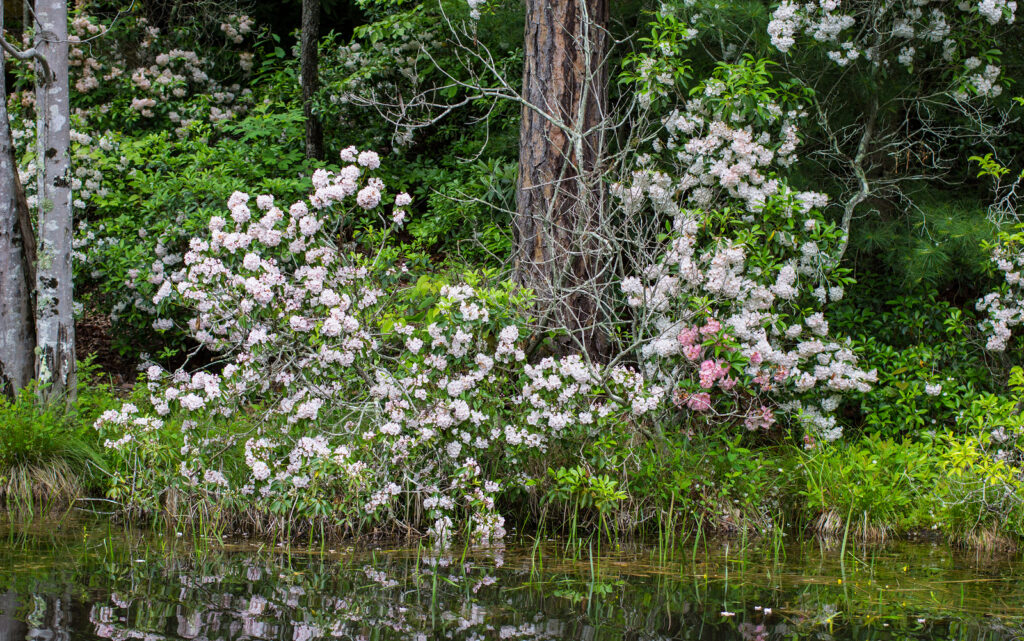Kalmia — commonly called mountain laurel –is a beautiful flowering shrub related to the rhododendron. Kalmia flower stalks bear a small bud that looks like a fluted turban; the buds open to chalice-shaped blooms with five star-like points. Flowers have anther sacs with dark dots–thus a second common name “calico bush.”
Kalmia is an evergreen shrub. Like rhododendrons, Kalmia grows best where the air is moist and the soil is well-drained. Kalmia like an acidic soil rich in humus. Kalmia tolerates shade but will bloom best in full sun.
Kalmia is a genus of seven evergreen shrubs. All are native to woodlands, swamps, and moist meadows.

Get to know Kalmia
- Plant type: Broad-leaved evergreen shrub.
- Growing zones and range: Zones 5 to 9.
- Hardiness: Hardy to Zone 5
- Height and width: 2 to 6 feet (1.8m) tall and wide depending on the cultivar (see below).
- Foliage: Glossy evergreen foliage; when not in flower, the laurel-like leaves of these species look a lot like those of the related rhododendron.
- Flowers: Clusters of cup- or bowl-shaped white, pink, or red flowers, often with markings; flowers are elegant and somewhat similar to rhododendron; the notable difference is that each long flower stalk bears a small bud resembling a fluted turban; buds open to chalice-shaped blooms with five starlike points.
- Bloom time: Late spring to early summer.
- Uses: Good backdrop for flower gardens, woodland gardens, or shady shrub borders.
- Garden companions: ‘Silver Queen’ wintercreeper (Euonymus fortunei ‘Silver Queen’)
- Common name: Mountain Laurel
- Botanical name: Kalmia
- Family name: Ericaceae
- Origin: North America and Cuba
Where to plant Kalmia
- Plant Kalmia in full sun if the soil is moist, or light shade.
- Plant Kalmia moist, humus-rich, well-drained, acidic soil.
- Kalmia grows naturally on slopes.
When to plant Kalmia
- Set out container-grown plants in spring or autumn.
- Layer Kalmia in summer.

Planting and spacing Kalmia
- Space Kalmia 6 to 8 feet (1.8-2.4m) apart.
- Amend soil with aged compost or planting mix before setting Kalmia in the ground.
How to water and feed Kalmia
- Give Kalmia regular water.
- Feed Kalmia with an all-purpose organic fertilizer in spring.
How to care for Kalmia
- Kalmia does not need regular pruning, but leggy plants can be pruned hard to stimulate new growth.
- Kalmia leaves and flower nectar are poisonous if ingested.
Kalmia pests and diseases
- Kalmia can develop blight, leaf spots, gall, or powdery mildew.
- Kalmia can be attacked by scale, weevils, or lace bugs.
Kalmia propagation
- Take Kalmia softwood cuttings in spring.
- Note that propagation for Kalmia is difficult.
- Layering Kalmia is a sure way to propagate the plant. Layer Kalmia in summer.
Kalmia varieties to grow
- Kalmia. angustifolia, Laurel: native to the eastern United States and Canada, this shrub averages 2 feet (.6m) high and spreads by stolons to 10 feet (3m) wide. The oblong, leathery leaves are 2 inches (5cm) long in whorls of three; bears early-summer, saucer-shaped flowers that range from lavender-pink to burgundy, rarely white, and are carried in 2 inch (5cm) clusters.
- K. latifolia, mountain laurel, calico bush: native to eastern North America from Canada to Florida, west across the Appalachians into states drained by the Ohio-Mississippi river systems; growing success diminishes the farther west you get, where summer heat, heavy soils do not suit it; success also depends on the plant’s source; plants from southern forms grow better in warmer zones; those from northern seed sources grow better in cold-winter regions; named selections are unlikely to perform well in all zones; slow-growing to 6-8 feet (1.8-2.4m) or taller, with equal spread; glossy, leathery, oval leaves are 3-5 inches (8-13cm) long, dark green on top, yellowish-green beneath; blooms in late spring; typically bears 1 inch (2.5cm) wide light pink flowers opening from darker pink buds, but blossoms often have a subtly different color in their throats and may have contrasting stamens; dlowers are carried in clusters to 5 inches (13cm) across. Cultivars of K. latifolia include: ‘Bay State’ has coral flowers ‘Bullseye’, bears dark purplish red blossoms with white centers; ‘Sarah’ has pinkish red blooms opening from red buds; ‘Carousel’, white flowers, with pink or red inside; ‘Elf’, pink buds, white blooms. 3 feet (.9m) tall; ‘Olympic Fire’ and ‘Otsbo Red’ have deep red buds opening to palest pink flowers; ‘Pinwheel’ produces flowers in a combination of deep red and white; ‘Silver Dollar’, large white flowers.
- K. microphylla, western laurel, alpine laurel: low growing plant has spreading branches with erect branchlets, small leaves (dark green above, whitish beneath), and rounded clusters of rose to purple, .5 inch (1.3cm) flowers n summer.; typical high-mountain form is 8-11 inches (20.3-28cm), with leaves up to .75 inch (1.8cm) long; s taller variety (to 2 feet (.6m) tall) with slightly larger leaves is K. occidentalis, it grows in coastal lowlands of California north to Alaska.



